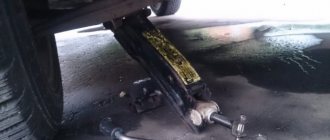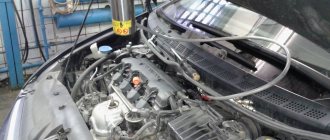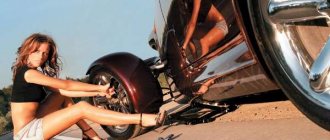Device, principle of operation, design of a hydraulic jack
The capabilities of hydraulic jacks are strikingly different from those of both mechanical and pneumatic counterparts. Key Features:
- load capacity from 1.5 to 200 tons (in some cases - up to 1000 tons);
- high efficiency - close to 80%;
- low working effort;
- smooth ride;
- high structural rigidity.
The disadvantages of most hydraulic jacks include the initially large height of most devices and the need for maintenance during operation.
We will look at the design and principle of operation of a hydraulic jack using the example of their most common type - a bottle plunger hydraulic jack. They come in different lifting capacities - 3 tons, 5 tons, 10 tons, etc.
Everything is quite simple: there is a piston in the cylinder and either in a separate reservoir or in the same cylinder above the piston there is hydraulic oil - the working fluid of the jack.
The hydraulic jack is activated by a plunger - a small pump that forces oil through the bypass valve into the cavity under the piston. Due to the difference in diameters of the plunger and the jack cylinder, the applied force is minimized. The liquid pumped under the piston pushes it out, lifting the load above it.
Lowering the jack is accomplished by slowly bleeding hydraulic oil from under the piston into the top of the cylinder or reservoir.
This is the principle of operation of all hydraulic jacks.
Another thing is that not all of them are equipped with a plunger pump, and the role of a plunger can be either a separate hand-held device connected to a jack or a hydraulic station
And now is the time to take a closer look at the types of hydraulic jacks, places and methods of their use.
Repair of the hydraulic part of the jack
Hydraulic repair comes down to draining the old fluid, completely disassembling the jack and replacing the seals and cuffs. There is nothing complicated about this, since the jack does not require any complex adjustments, only diagnostics, maintenance and, if necessary, replacement. And all sealing elements and cuffs without exception must be replaced. We strongly recommend not to go to workshops and especially not to look for original seals - it is practically useless. The fact is that almost all sizes of hydraulic jacks, or more precisely, their seals, are standard and can be sold at any point that deals in consumables for tractor and automotive hydraulics. It will be three times cheaper, the main thing is to measure the rubber parts or take them with you.
Types of hydraulic jacks, their advantages and disadvantages
The first of those mentioned, the most common and well-known are bottle-type jacks; they are often (based on the most classic application) called automobile hydraulic jacks.
Their line for most manufacturers starts from one and a half ton models and reaches 15 – 20 ton modifications. They are simple in design, compact in installation and unpretentious in maintenance; they can faithfully serve the zealous car owner for many years.
Actually, maintenance, in most cases, comes down to checking the oil level, topping it up if necessary, and periodically idling the jack so that during operation all its parts can be lubricated, the springs work and the bypass valve balls rotate, which will prevent them from sticking due to for infrequent use and will not lead to device inoperability in a critical situation.
Just because of the possibility of oil leakage, it is better to store bottle hydraulic jacks in a vertical position.
Repair of such jacks is carried out extremely rarely, but if the jack is worn out - for example, at a service station or in another production facility, then it most often comes down to replacing the piston and plunger cuffs, rubber seals, and less often - springs and balls of the bypass valve.
Advantages of a bottle hydraulic jack:
- compactness;
- sustainability;
- durability;
- low applied force;
- versatility of use - in addition to motor vehicles, such jacks are used in construction, on railway transport, as a power unit for pipe benders and pipe cutters;
- ease of repair.
It is these jacks that are the main and practically no alternative for trucks.
Their disadvantages include:
- large initial height;
- low lifting height;
- impossibility of working in a non-vertical position.
Nowadays, automobile hydraulic jacks are produced in convenient compact packaging, making their installation and storage in a car, especially during long trips, very convenient and neat, preventing damage to things transported in the luggage compartment due to possible oil contamination.
By the way, the shape of the drawers and the location of the handles transparently hint at vertical storage of bottle-type jacks. But a rolling hydraulic jack does not have these disadvantages, although it is more expensive and less compact, but as a car jack it is not inferior to a bottle jack, and in some cases even surpasses it, in particular:
- when working on sites with a slope;
- has a significantly lower pick-up height;
- easier to move and install under the car thanks to wheels;
- has a higher lifting height (from 300 to 400 mm).
We would recommend that cars driven by women be equipped with these types of jacks.
Another, in our opinion, interesting model of a car jack is created by combining two types of this device: rhombic screw and hydraulic. This is, of course, a hydraulic jack, but its force is transmitted using levers to a rhombic lifting device, which has undeniable advantages:
- low pick-up height;
- absence of deviations in the vertical plane during lifting;
- high lifting height.
We would be wrong if we do not mention some lesser-known, but no less useful representatives of hydraulic jacks.
Advantages and disadvantages of this type of jacks
Like any technical device, a rolling jack has both its advantages and disadvantages. Let's start with the first ones. So, their advantages include:
- High coefficient of efficiency (efficiency). With its help, you can lift a car of considerable weight with minimal physical effort.
- High load capacity. This was made possible by the use of a horizontal cylinder and a removable handle.
- Slow lifting ensures neat operation and safety. And the shut-off valve ensures that the load is secured at any selected height.
- The presence of a support platform provides good stability and safety.
- Convenience and ease of use of the jack.
- Be careful and clean when working with the jack. The operator does not need to lie down on the ground or garage floor in order to place the jack under the car.
Choosing a hydraulic jack for your purposes
In addition to purely automobile ones, or rather it would be more accurate to say: predominantly automobile ones, there are other hydraulic jacks that not only push out the piston, but also retract it.
Moreover, they can do this both on one side and on both sides. These and similar jacks are most actively used in car body repairs or similar industries.
They, as a rule, do not have their own plunger and are used with an external oil injection device: either manual or electric.
The same external device is also needed for hydraulic jacks with a stepped lift height or with a nut fixation.
These are specific jacks, more often used in production, but in the conditions of a car repair shop, including... repair of trucks, they can become indispensable assistants, given their:
- exceptional reliability and durability;
- high (significantly greater than that of bottle hydraulic jacks) lifting capacity;
- no need for additional cargo securing;
- no need for human effort during lifting at all.
Comments2 comments
Thank you. Very interesting article
Another disadvantage of hydraulic jacks is not the mechanical component of the design itself, but the hydraulic one, that is, oil can become a problem in severe frosts; you need to pay attention to the performance characteristics of the working fluid. but the insignificance of the stroke is fully compensated for by telescopic hydraulic jacks, but I have not yet come across such a sensible jack, a la a domestic manufacturer.
Every car enthusiast sooner or later is faced with the need to use such an important automotive unit as a rolling jack. Repairing a car or replacing wheels very often cannot be done without this device. But first you need to figure out what kind of mechanism it is.
A jack is a special device that allows you to lift and fix heavy weights at a certain height. Every car owner will be able to appreciate its advantages.
The most convenient and effective device is considered to be a hydraulic jack, which operates thanks to special hydraulic oil and a piston. Such a rolling jack, the repair of which is very simple, will be useful not only for car repair specialists, but also for every owner of an iron friend.
How to make a rolling jack with your own hands
Some craftsmen and car enthusiasts make a rolling jack with their own hands. Oddly enough, this does not require complex equipment. As a rule, the basis of a rolling jack is a regular bottle jack, which works according to a similar scheme - on a hydraulic drive. A diagram of one of these homemade devices is presented below.
A homemade jack is suitable for use in garage conditions and for lifting a passenger car (the exact lifting capacity depends on the bottle jack used and its location in the welded structure).
Safety precautions
Any jack is not only an auxiliary tool when repairing a car, but also a potential source of threats both for the car and the people around it.
Car latches at height
If you need to crawl under the bottom of the car, be sure to place wheel chocks, bricks or other objects under the wheels in order to reliably immobilize the wheels. If you are not sure of the serviceability of the jack or even a small amount of oil leaks from it during the lifting process, then you should not leave the car suspended on such a device for a long time. Be sure to replace the jack with a secure support and remove the jack.
Results
A rolling hydraulic jack is a very convenient tool used both at service stations and by private car owners. The choice of a particular model should be based on its technical characteristics, the authority of the manufacturer and reviews of real owners of these devices.
First of all, pay attention to the load capacity . This is especially true for service stations, as well as owners of large cars - SUVs, crossovers and minibuses. Also look at the minimum and maximum heights that the jack can operate from. To do this, find out in the technical documentation the ground clearance of your car.
As for the price, it is better not to buy very cheap jacks, but you should not overpay. It is better to stay with a device from the mid-price segment. For most ordinary car owners it will be enough. If you need a jack for a service station, then you should take a closer look at more expensive professional devices.
Carrying out repairs on a rolling jack with your own hands does not present any particular difficulties for a person who has knowledge in the field of technology.
Operating principle of a rolling jack
A rolling jack is considered hydraulic, but has a slightly different structure. What distinguishes it from others is the appearance of the body, since it has two pairs of new wheels. The device is capable of gradually lifting the car, while the device itself rolls under it. The rolling jack (the device and repairs can be studied independently) is driven by swinging the lever. But to lower it, you need to use a special valve screw by turning it.
There are different types of rolling hydraulic jacks. They are divided depending on the weight of the cars they will have to lift. These can be either cars weighing up to three tons or trucks weighing about twenty tons. Despite such huge weight indicators, the rolling hydraulic jack does its job quite quickly and efficiently.
Principle of operation
Any hydraulic jack works on the same principle; they are based on Pascal's law. It says that external pressure on a liquid or gas has initial characteristics at any point in any direction.
Two vessels connected by a channel are installed on the base. One vessel contains a piston that raises or lowers the load. Two valves are installed in another vessel:
- one - for pumping liquid into a vessel with a piston;
- the second is for sucking in liquid to replace the squeezed out one.
Working fluid - its role is assigned to technical oils.
Using a long, removable handle, a person pumps oil into the cylinder with minimal effort. The cylinder moves the piston and, accordingly, the lifting platform. The pressure created in this way is capable of lifting and holding large loads.
To lower the load, you must open the bypass valve and return the oil to the original container. To do this, using the inflation handle, turn the bypass valve screw and release the pressure, the platform smoothly lowers.
If smooth and precise movement of a hydraulic jack is required, it is recommended to opt for a transmission dolly lift. This mechanism is equipped with a rotating frame and a hydraulic system with a high level of smoothness . This unit is designed to perform work with the ability to fix a vertical or horizontal position.
Hydraulic jacks are capable of lifting loads up to two hundred tons. Such powerful mechanisms have found application in industry and the railway sector. A hydraulic lift up to 3 tons is considered optimal for use.
Main causes of breakdowns
A rolling jack, which can be repaired at home, can have several causes of breakdowns. The most common of them are: complete or partial failure of the device to lift heavy loads, as well as oil leakage. Each of these problems requires immediate repair.
The rolling jack (repair, oil change, characteristics are described in detail in this article) very often fails as a result of oil leakage. In this case, you will have to completely disassemble the device. Be sure to remove the pistons and check for corrosion. Thoroughly clean all structural elements and remove all kinds of dirt. Now check the stem. If you find that it is warped and damaged, you may not even try to repair it yourself. In this case, you will most likely have to purchase a new jack.
Another common reason for device failure is clogging or breakdown of special valves, which, in fact, are responsible for lowering and raising the mechanism.
Valves flushing
Repair of rolling hydraulic jacks should begin with thorough washing of the valves. This is done in order to thoroughly clean the device of all accumulated contaminants. Before carrying out this procedure, prepare in advance a special container into which you will pour the old liquid. While the fluid is draining, be sure to bleed the system. This must be done using the operating lever by lowering and raising.
After this procedure, which in no case should be ignored, the valves are washed, which cleans the device of the remains of old working fluid and accumulated contaminants. Repairing a rolling car jack on your own involves the mandatory replacement of all cuffs and sealing gaskets. If contaminants get directly into the work surface, clean it by unscrewing the housing head.
Now fill the tank with a special flushing liquid or kerosene and pump it. Once you have done this, fill the reservoir with clean working fluid.
Bottle type jack device
Bottle jacks have become quite widespread. This is due to their low cost, as well as the simplicity of the design and its reliability. The design of a bottle-type hydraulic jack is characterized by the presence of the following elements:
- Main piston.
- Stock.
- Lever arm.
- Working fluid suction valve.
- A safety element that prevents fluid from flowing in the opposite direction.
- A container in which oil is stored.
- Working chamber.
Only by ensuring the tightness of the structure can reliable operation of the device in question be ensured. In the manufacture of the outer casing, cast iron or steel is used, which can withstand high loads.
The design of the bottle jack determines that as the size of the mechanism increases, the load capacity also increases.
Malfunction caused by air bubbles
Very often, the jack may begin to malfunction due to reasons such as the accumulation of air bubbles in the working area. Most often, this phenomenon occurs with a very small amount of oil.
Repairing rolling hydraulic jacks with this problem can be done at home. First, you will have to remove the plug in the oil reservoir, opening the bypass valve. After this procedure, you should quickly bleed the pump of your jack. By the way, this needs to be done at a very fast pace. With this procedure you will be able to transfer the bubbles into the oil container.
Now that you have completed this procedure, do not forget to close the oil tank cap and the bypass valve itself. If you strictly follow all the instructions, then your jack will begin to work perfectly, as it did only after purchase. If after this procedure you were able to detect residual air, then repeat these steps one more time.
How to bleed a hydraulic (bottle) jack since it has stopped lifting and is springing?
I have a hydraulic (bottle) jack from Kuvalda 5 tons, all the liquid was accidentally drained from it. Is the fluid suitable for power steering and should I bleed it at all? Maybe someone can tell me?
- Steering wheel vibration when braking! SOSSSSSSSSSSSSS
- selection of brake discs
- chassis Volkswagen Passat (B3/B4)
- When it's hot, it won't start until you press the gas to the floor, and then you have to turn it for a long time?
- Autotest
- Do you want clear headlight reflectors?
A spindle (spindle hydraulic AU) is poured into hydraulic jacks, so it prevents the formation of an emulsion, protects equipment from wear and corrosion, and has high performance properties.
Look at how a guy repairs a hydraulic jack, everything is very accessible and detailed. And that’s for sure about the spindle, power steering fluid is not suitable, IMHO.
Before pumping: 1. you need to check the valve; to do this, unscrew the valve and check for deformation or dirt getting inside the valve; if the valve is in a faulty state due to mechanical deformation, then it simply needs to be replaced; 2. you need to drain the oil completely; 3. all parts must be washed to remove dirt and oil; 4. Open the oil tank cap and the bypass valve, and then quickly pump the hydraulic press pump several times.
You need to pump it like this, there is a hole on the side of the jack, through it you fill in spindle oil or any hydraulic fluid (not important), then push the piston out all the way using the hydraulics, put the jack on its side with the filling hole up and press in the piston - this should force the air out of the hydraulic cylinder, then, if necessary, add oil and, if necessary, repeat the operation a couple of times.
You need to add hydraulic fluid; from the factory, if my memory serves me correctly, they pour red hydraulic fluid. The main thing is not to pour the waste into it, otherwise they are weirdos))) Okay, it’s closer to you, you pour the liquid into the hole, which is located in the middle of the body, screwed with a plug, the most convenient way to pour the liquid is with a medical syringe, screw this plug well and release the tetrahedron (as if lowering ). You pump it 20 times, tighten it, raise the rod (you can jack something up). If he lifts and holds, then everything is fine, if not, then you will have to repeat the manipulations.
Selecting and purchasing a quality jack
If you want to buy a 3t rolling jack, then, no matter how expensive your tool is, it will still break down periodically. Therefore, you just need to familiarize yourself with the basic rules of its operation, as well as the basics of repairs at home. In order to do the repair work yourself, do not forget to buy a special set of wrenches, as well as a special flushing fluid and oil.
When choosing a hydraulic rolling jack, you need to consider several parameters. If you want to use it at home, then you can buy a unit that will be ideally suited to the weight of your car. Most often this is a 3t rolling jack. If you want to buy a device for working in a workshop, then you will need a device with a large load capacity and high lifting speed. When buying a jack, it is better not to save money, as a high-quality product will break less often and will last you much longer.
The rolling jack stopped lifting
Sometimes problems arise with hydraulic jacks. Most people throw them away immediately. But don’t throw it away, maybe the problem isn’t that big.
But it happens that the jack does not raise it to the required height. Previously, for example, the length of the rod was enough to lift the car, but now it is not. It rises halfway and that’s it. Oil is to blame here. More precisely, its lack.
When a working jack works, oil is still consumed. Quite a bit, but it is used up with each rise/fall. For good reason, it should be changed from time to time - about once a year. But who does this kind of nonsense here?) Usually it works as long as it works)
In general, two of my jacks malfunctioned. One is rolling, the other is bottle-type, both are hydraulic, of course. A rolling jack is the same as a bottle jack, only installed in a special design. After I raised the car, they slowly lowered it. I decided to add oil.
In general, it is recommended to add special hydraulic oils to such jacks. You can go and buy it, you can fill it with spindle oil, which is also hydraulic. Or you can, at your own peril and risk, top up with regular engine fuel. Which is what I did. This, of course, is not recommended, the properties of the oil are not the same, but oh well
.
First you need to lower the jack completely. We unscrew the fitting, lower the rod (or the lifting part of the rolling part), and screw the fitting back. We find the hole through which the oil is poured. It is closed with a rubber plug.
There is often information that rolling jacks often stop holding the load after a short time. The same situation happened to me. I decided to change the stub bushings, hung the car, substituted the bars, but did not loosen the jack, as it was holding it before. After a while I looked, and the jack went down without any load. I didn't like it, but oh well. Changed the bushings. You need to put on the wheel. I start to lift the car with a jack, and it immediately lowers. That is, if you pump at a frantic pace, then somehow it still rises, but as soon as you stop, it falls. Somehow I put the wheel on and decided to disassemble the jack. Here's my handsome guy:
I scattered it. I took off the pump, removed the outer casing, took out the rod with the cuff, and then I just went nuts. What do I see on the inside of the cylinder, in which the rubber cuff goes:
You can feel them when you run your finger over them. It is clear that they are made artificially. If the jack is not raised to the maximum height, then the cuff will not reach these scratches, but this is unlikely to happen unless you check its performance in a store when selling it. And here's what happened to the cuff:
How to increase sales of jacks? Yes, it is necessary to artificially limit their service life. Not many will look for the cause of the malfunction and go buy a new one. The dear toad will strangle the borrower and take the same one in the hope that it will work for at least a year. I decided not to buy a new one, but to grind the cylinder. Don’t think that I’m a weak person, but I couldn’t unscrew this cylinder, although I made a decent effort. The gas key strips off the metal, but this garbage didn’t want to turn away.
I spat on it and decided to grind off the scratches and stuff cold welding into the recess. I polished them with a scratch pad, then welded the seams and polished them again. It turned out fine, the scratches were no longer felt to the touch
Rules of care
If a 2-ton rolling jack does not lift, repairs can be carried out at home. But to prevent this from happening, timely prevention must be carried out. Of course, no one says that the device will last indefinitely, but you can extend its service life several times.
Provide good storage conditions for the jack. Monitor the quantity and quality of the working fluid. Clean the device from dirt in a timely manner. Do not forget that it is not recommended to overload the device.
Review of popular models of hydraulic rolling jacks
We list several popular rolling jacks in our country. Both imported and domestic.
| Name | Minimum height, mm | Maximum height, mm | Load capacity, tons | Note |
| Nordberg N3203 | 133 | 465 | 3 | Distributed to domestic service stations |
| “Bison Master” | 135 | 385 | 2,1 | Missing rubber heel |
| “Matrix 510335” | 130 | 410 | 3 | Overload protection available |
| Ombra OHT203 | 192 | 533 | 3 | An original repair kit is included with purchase. |
| Airline AJ-3F-390P | 135 | 390 | 3 | Weight - 13 kg |
| "Stealth" | 100 | 350 | 2 | Weight - 12 kg |
| “Sorokin 3.520” | 125 | 300 | 2 | Weight - 6.5 kg |
| Biloxxi GTJ2004 | 130 | 336 | 2 | Good value for money |
| Forsage TH22501CB | 140 | 387 | 2,5 | There are three fixed levels at a height of 222, 285, 340 mm |
| “Ermak” | 135 | 385 | 2 | A very popular jack among car enthusiasts |
Helpful operating tips
Immediately before the oil filling process, carefully read the operating instructions for your particular model of hydraulic jack. After all, sometimes there are cases when the oil filling process is slightly different from that described above.
Before starting use, it is recommended to get rid of excess accumulated air in the device. Raise the device and lower it to the minimum. This will remove all unnecessary air.
Use only time-tested liquids. Do not use liquids containing alcohol.
In this article we will look at the most popular types of jacks for service stations - rolling jacks. What are their features, what are they, and how do they work? We will answer all your questions.
How to fill oil correctly
It is the lack of oil in the jack that leads to its poor performance. Fortunately, such a breakdown is easy to fix - you just need to add liquid. However, you should know what exactly to add.
High-quality fluid will ensure long-term operation of the mechanism:
- Industrial types of industrial oil. But not types I30A, I40A, I50A - they are too viscous.
- Brake fluid is excessively hygroscopic, that is, it absorbs water vapor. And water will eventually lead to corrosion and failure.
- Branded hydraulic fluids are manufactured specifically for brake and lifting systems.
- The water jack won't last long, but it will work.
After the fluid has been selected, it is necessary to carry out preparatory work to replace it.
First, the old fluid is drained. To do this, unscrew the plug and pump the device. Next, the jack is washed with cleaning fluid, which can be purchased at a hardware store. The solution is poured and drained. Before adding new oil, there should be no foreign liquid in the jack.
How to unscrew the plug
Afterwards, the jack is set to the lowest position, and the screw-cock is turned to the “Drain” position. Oil is poured. The required level is indicated by a mark on the jack.
After the first filling, the plug is closed and the jack is run 5-6 times. The plug is opened again and oil is poured in. It is necessary to repeat several times until the oil stops leaving.
After the final filling of the oil, a test distillation of the liquid is performed again to get rid of air. To do this, the jack is pumped - raised and lowered - until pressure appears. Excess air is released through special tubes; oil must be added in its place as it exits.
Rolling jack device
By itself, a jack is a device for lifting loads to a small height. The principle of operation can be radically different, from spring to pneumatic. There are many models, but a special place is occupied by rolling car jacks , which operate on the basis of hydraulic or pneumatic force. These mechanisms received their name due to the design features, which consists of:
- lifting pillow;
- a long handle or compressor that applies pressure;
- durable frame;
- valve systems;
- small wheels that allow the device to move.










